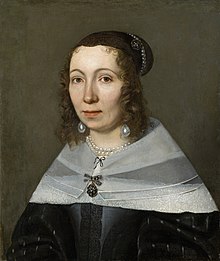
Back Maria Sibylla Merian Afrikaans Maria Sibylla Merian ALS ماريا سيبيلا ماريان Arabic ماريا سيبيلا ماريان ARZ Maria Sibylla Merian AST Mariya Sibilla Merian Azerbaijani Марыя Сібіла Мерыян Byelorussian Мария Сибила Мериан Bulgarian Maria Sibylla Merian Breton Maria Sibylla Merian Catalan
Maria Sibylla Merian | |
|---|---|
 Portrait by Jacob Marrel, 1679 (Kunstmuseum Basel) | |
| Born | 2 April 1647 Free Imperial City of Frankfurt, Holy Roman Empire |
| Died | 13 January 1717 (aged 69) |
| Occupations |
|
| Known for |
|
| Spouse |
Johann Andreas Graff
(m. 1665) |
| Children | |
| Parents |
|
Maria Sibylla Merian (2 April 1647 – 13 January 1717[1]) was a German entomologist, naturalist and scientific illustrator. She was one of the earliest European naturalists to document observations about insects directly. Merian was a descendant of the Frankfurt branch of the Swiss Merian family.
Merian received her artistic training from her stepfather, Jacob Marrel, a student of the still life painter Georg Flegel. Merian published her first book of natural illustrations in 1675. She had started to collect insects as an adolescent. At age 13, she raised silkworms. In 1679, Merian published the first volume of a two-volume series on caterpillars; the second volume followed in 1683. Each volume contained 50 plates that she engraved and etched. Merian documented evidence on the process of metamorphosis and the plant hosts of 186 European insect species. Along with the illustrations Merian included descriptions of their life cycles.
In 1699, Merian travelled to Dutch Guiana to study and record the tropical insects native to the region. In 1705, she published Metamorphosis Insectorum Surinamensium. Merian's Metamorphosis has been credited with influencing a range of naturalist illustrators. Because of her careful observations and documentation of the metamorphosis of the butterfly, Merian is considered by David Attenborough to be among the more significant contributors to the field of entomology.[2] She discovered many new facts about insect life through her studies.[3] Until her careful, detailed work, it had been thought that insects were "born of mud" by spontaneous generation. Her pioneering research in illustrating and describing the various stages of development, from egg to larva to pupa and finally to adult, dispelled the notion of spontaneous generation and established the idea that insects undergo distinct and predictable life cycles.[4]
- ^ Rogers, Kara. "Maria Sibylla Merian". Encyclopædia Britannica. Archived from the original on 23 June 2018. Retrieved 31 March 2018.
- ^ Natural Curiosities film, BBC
- ^ Kristensen, Niels P. (1999). "Historical Introduction". In Kristensen, Niels P. (ed.). Lepidoptera, moths and butterflies: Evolution, Systematics and Biogeography. Volume 4, Part 35 of Handbuch der Zoologie:Eine Naturgeschichte der Stämme des Tierreiches. Arthropoda: Insecta. Walter de Gruyter. p. 1. ISBN 978-3-11-015704-8.
- ^ Cite error: The named reference
Soldiershop Publishingwas invoked but never defined (see the help page).